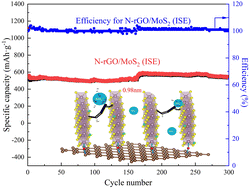An interlayer spacing design approach for efficient sodium ion storage in N-doped MoS2†
Abstract
MoS2 in a graphene-like structure that possesses a large interlayer spacing is a promising anode material for sodium ion batteries (SIBs). However, its poor cycling stability and bad rate performance limit its wide application. In this work, we synthesized an N-doped rGO/MoS2 (ISE, interlayer spacing enlarged) composite based on an innovative strategy to serve as an anode material for SIBs. By inserting NH4+ into the interlayer of MoS2, the interlayer spacing of MoS2 was successfully expanded to 0.98 nm. Further use of N plasma treatment achieved the doping of N element. The results show that N-rGO/MoS2(ISE) exhibits a high specific capacity of 542 mA h g−1 after 300 cycles at 200 mA g−1. It is worth mentioning that the capacity retention rate reaches an ultra-large percentage of 97.13%, and the average decline percentage per cycle is close to 0.01%. Moreover, it also presents an excellent rate performance (477, 432, 377, 334 mA h g−1 at 200, 500, 1000, 2000 m A g−1 respectively). This work reveals a unique approach to fabricating promising anode materials and the electrochemical reaction mechanism for SIBs.

- This article is part of the themed collections: 2024 Lunar New Year Collection, New horizons in materials for energy conversion, optics and electronics, Nanoscale Horizons Highly Cited Articles and Nanoscale Horizons and Nanoscale: Nanomaterials for Energy


 Please wait while we load your content...
Please wait while we load your content...